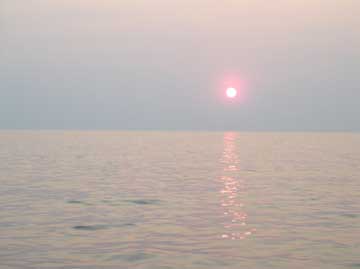|
NEWS NOTES
Geophenomena
Using the sun cycle to predict African rains
 Curt Stager |
| Lake Tanganyika is one of the African lakes that researchers studied to determine how the sunspot cycle affects rainfall in East Africa. |
The heavy rains that periodically flood East Africa and bring mosquito-borne epidemics may be connected to the sunspot cycle, according to a study published Aug. 7 in the Journal of Geophysical Research. Because the 11-year sunspot cycle is so regular, researchers say it could give government and public health officials a simple way of preparing for the floods, erosion and Rift Valley Fever outbreaks that accompany the rains.
This study, led by Curt Stager, a paleoclimatologist at Paul Smith’s College in New York, is not the first to connect rainfall in East Africa with the solar cycle — scientists have entertained the idea since the early 1900s. But it has long been debated because the water levels in Lake Victoria, used as a measure of rainfall in East Africa, did not appear to rise with the sunspot peaks between 1927 and 1968. Thanks to the poor correlation in the middle of the century, previous studies argued against the connection between solar cycles and precipitation. Stager’s team says, however, that lake levels were indeed at their highest during the sunspot peaks, but intervening El Niño activity during this time kept the levels high in-between the peaks, thus obscuring the effect of the sun.
Using Lake Victoria as a gauge for rainfall in the surrounding area, Stager and his team compared monthly lake level records over the last 100 years with records of the solar cycle and the El Niño index. They found that all nine of the past century’s sunspot maxima coincided with maximum water levels in the lake. Because many variables can affect rainfall, the researchers used a method called wavelet analysis to interpret the data. Wavelet analysis allows researchers to separate the peaks, or strong signals, from the general background signals over a given time period. The method allows for more subtle analysis than a straightforward correlation, which would lump all the signals together, Stager says.
Stager’s team determined that the water levels of Lake Victoria are a good gauge of precipitation, and that because of delayed runoffs from the watershed, it takes about a year after a heavy rain for the lake’s level to peak. Because the lake levels peak at roughly the same time as the sunspot cycle in the record, the team says, the heavy rains must come before the solar maxima. Sunspot peaks mark periods of intense magnetic activity.
Sunspot peaks can generate rainfall by any number of processes, the team says, including that a stronger sun heats up the oceans in the equatorial regions, leading to more evaporation and more rainfall. But that explanation doesn’t account for why the heavy rains fall before the peak in the sunspot cycle, Stager recognizes. “That’s the scary part — we don’t know,” he says.
Stager’s team suggests that a connection between the solar cycle, which is roughly 11 years, and the El Niño cycle, which averages five and a half years but is quite variable and unpredictable, may explain the timing of heavy rains and the peak in the sunspot cycle. Both El Niño and the sunspot peak generally increase the rainfall in East Africa, but other factors can limit just how much each individually would increase the rainfall.
El Niño may be “like a squirt gun that has to be loaded up, and then when it’s fired off, it has to refill,” Stager says. “Well, we’re guessing that the sun has something to do with when it goes off,” he says. “The oceans are warming up and it might not have to be at the [sunspot cycle] maximum before they set off the El Niño. It goes off, and it can’t really do anything before it’s refilled. Meanwhile the [solar] peak passes,” he explains.
David Salstein, a climatologist at Atmospheric and Environmental Research, Inc., in Lexington, Mass., says that he is wary of making the connection between El Niños and sunspot activity because it implies that half of the El Niños have a different cause than the other half, as not all El Niños correlate with the sunspot cycle. Instead, he says, solar features other than sunspots can affect the energy output of the sun. Thus, another possible explanation for East African rains peaking before the sunspot maxima could be that some aspects of the energy output of the sun are slightly out of phase with the sunspot cycle.
Whatever the mechanism, even in the absence of a rigorous explanation for how the solar cycle affects rainfall, “the link between sunspots and lake level is clear,” Salstein says, suggesting there is a pretty clear correlation between increased rainfall and sunspot activity, he says. And given that Kenya’s Rift Valley Fever outbreaks over the past 50 years have coincided with elevated water levels in of Lake Victoria, Stager says that he hopes people will not ignore this correlation, and that perhaps they will use the sunspot cycles to predict heavy rainfall events, and thus fever outbreaks.
The next peak in the sunspot cycle will likely come between 2011 and 2012 (see Geotimes, June 2007), so Stager predicts we should see heavy rains pummel East Africa sometime between 2010 and 2011.
Links:
"Sun cycle to flare back up in 2008," Geotimes, June 2007

 Subscribe
Subscribe


